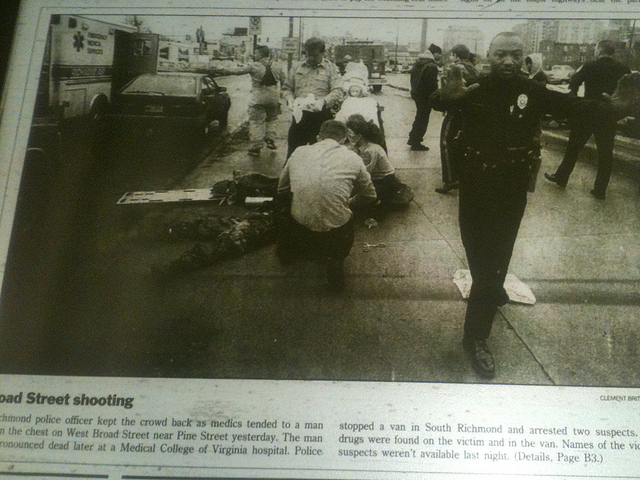
Richmond’s worst year?
Richmond bottomed out in 1994: one city councilman went off to rehab for his heroin problem and another was in hot water for not paying utilities and renting out condemned property, enrollment at VCU dropped, the city recorded the nation’s 19th largest population decline since 1980, Richmond made the wrong end of Money Magazine’s Best Places to Live list, and by the end of the year had tallied a record 161 homicides. With recent years showing the lowest body counts since 1961, the city’s population back up over 200,000, and VCU having greatly expanded, it is difficult to imagine that mid-1990s Richmond was ever real.
That year’s spike in killings did not arrive suddenly. Richmond’s body count had topped out over 100 for the previous 6 years and the city had already earned a dangerous reputation by the mid-1980s (if not earlier). The Briley Brothers’ 1979 killing spree and 1984 escape from death row were in recent enough history. Southside’s Johnson/Brown gang, estimated to be responsible for 30 lives over 3 years, were only recently off the streets. The leaders of the notorious Newtowne gang were locked up in 1992 after killing 13 people in “a furious month and a half”.
Curious about and fascinated by Richmond’s shockingly violent semi-recent history, I thought to look and see where all of this killing was taking place. It seems that to be able to say that certain areas once had these incidents but do not any longer would be a useful way of marking the changes in the city. Unfortunately, the Richmond Police are not able to easily provide data for the years before 1998, so to get a look at anything earlier I had to dig it up for myself. Given the time involved, I chose to pull the info only for 1994, which to get I had to dig through the year’s worth of the RTD at the Library of Virginia.
This work identified 158 homicides (PDF) – not a perfect data set, but close enough to have a sense of what was going on where in 1994. Because the information was pulled from news accounts, some of the dates and locations might be somewhat off, but are generally accurate.
It was a hell of a year. Where we now have months with no killings, a Times-Dispatch article that year thought a 10-day span without a homicide was noteworthy. At one point during the year, the bodies were dropping fast enough to put the city on target for 182 killings by the end of December. August 1994 was the worst month in Richmond’s history for killings at 25, or almost one every day. Things got so bad that the U.S. Postal Service stopped mail delivery to Whitcomb Court until ordered back on the rounds by a Federal judge. Stories on Richmond murder made both America’s Most Wanted and got notice in December 5 piece in USA Today.
In addition to the homicides in the city, there was an amplified smear of of violence across the region that year, with multiple accounts of drive-by shootings and gunmen firing into crowds making the newspaper (including the article above, on shots fired into a crowd gathered around an ambulance). This was a level of violence virtually unimaginable today: 2 would-be robbers of a Henrico jewelry store were killed in a shoot-out with the police, 2 Chesterfield teens robbed and killed a car salesman, a man killed 2 elderly women in 2 different retirement homes, an infant was basically boiled to death, “two masked gunmen opened fire in the parking lot” at 5PM on a Sunday evening on Meadow Street, one single block of Afton Avenue recorded 5 separate killings over the course of the year, an entire family was slaughtered in Gilpin Court, and there was a triple killing in Sugar Bottom. By fall, the police were on Full Alert and were setting check points at hot spots across the city.
The vast majority of the victims that year were young black men, and they were shot to death. There were anomalies – a fatal stabbing in a the kitchen of a Chinese restaurant on Grace Street, the murders of 2 elderly women in retirement homes, a body found in the canal by Tredegar Street – but overwhelmingly the stories from 1994 are those of young black men found dead or dying on streets like Idlewood Avenue, Hull Street, and Afton Avenue. Violence in the black community was a recurring topic in the media, framed with anger and helplessness.
This year of murder brought Richmond a real boogie man. On October 14, 1994, 20-year-old Christopher Goins went to the Gilpin Court apartment of 14-year-old Tamika Jones, who was seven months pregnant with Goins’ child, and killed Tamika’s parents, her 9-year-old sister, Nicole, her 4-year-old brother, David, and her 3-year-old brother, Robert. Chilling accounts of the killing (PDF) say that Goins had previously discussed doing away with Tamika and her family, shot each of his victims in the head on that gruesome day, and that he shot the pregnant teen nine times.
Goins escaped the scene of the shooting and went on the run, leading to a manhunt by Richmond Police and the FBI that stretched from Virginia to New York. The search for Goins and Richmond made an appearance on America’s Most Wanted and a $15,000 reward was offered for his arrest. The search for Goins dominated the headlines in Richmond in the weeks before he was captured, seeming to take the focus of police and communities otherwise unable to stop the flood of violence around them. Goins was arrested in Brooklyn, entered death row on July 20, 1995, and was executed on December 6, 2000.
Looking at the map or list of incidents from 1994 in comparison to recent years and one thing really jumps out: Byrd Park/Randolph was apparently a very different place back in the bad ol’ days. There were 9 killings in the Byrd Park/Randolph/Maymount area in 1994, including an early evening double homicide in a store parking lot. The level of violence and the number of drug-related street killings really do not line up with that area in 2010, hands-down the most changed in Richmond over the past 16 years.
Looking at the map for the East in 1994, the 13 killings in the Church Hill area south of Fairmount seem indicative of the changes between now and then. Any one or two of these incidents might happen in a given year, but that year seemed to see it all (including a triple killing on 31st Street in Sugar Bottom, and twin killings on 30th/O Street and 30th/P Streets less than 24 hours apart).
As the number of killings in the East End has dropped, the rate has dropped in some areas and killing has started to disappear from others. There is a growing area of the East End, encompassing Union Hill, St.John’s, the southern areas of Fairmount and Church Hill North, Fulton, and Montrose where this type of violence has receded since 2006–07 and is increasingly foreign. (I don’t think anyone would be surprised to see a body drop on Venable Street, though…)
The sheer number of killings on Southside in 1994 is shocking. With at least 70 murders mostly packed into a few dense areas, specific streets along the Jeff Davis corridor were awash with blood: Afton Avenue had 5 killings, Lynehaven Avenue had 7, the area around Minefee/Harwood/Southlawn had 6. The area within a 1/2 mile radius of Afton and Lynhaven saw 17 killings.
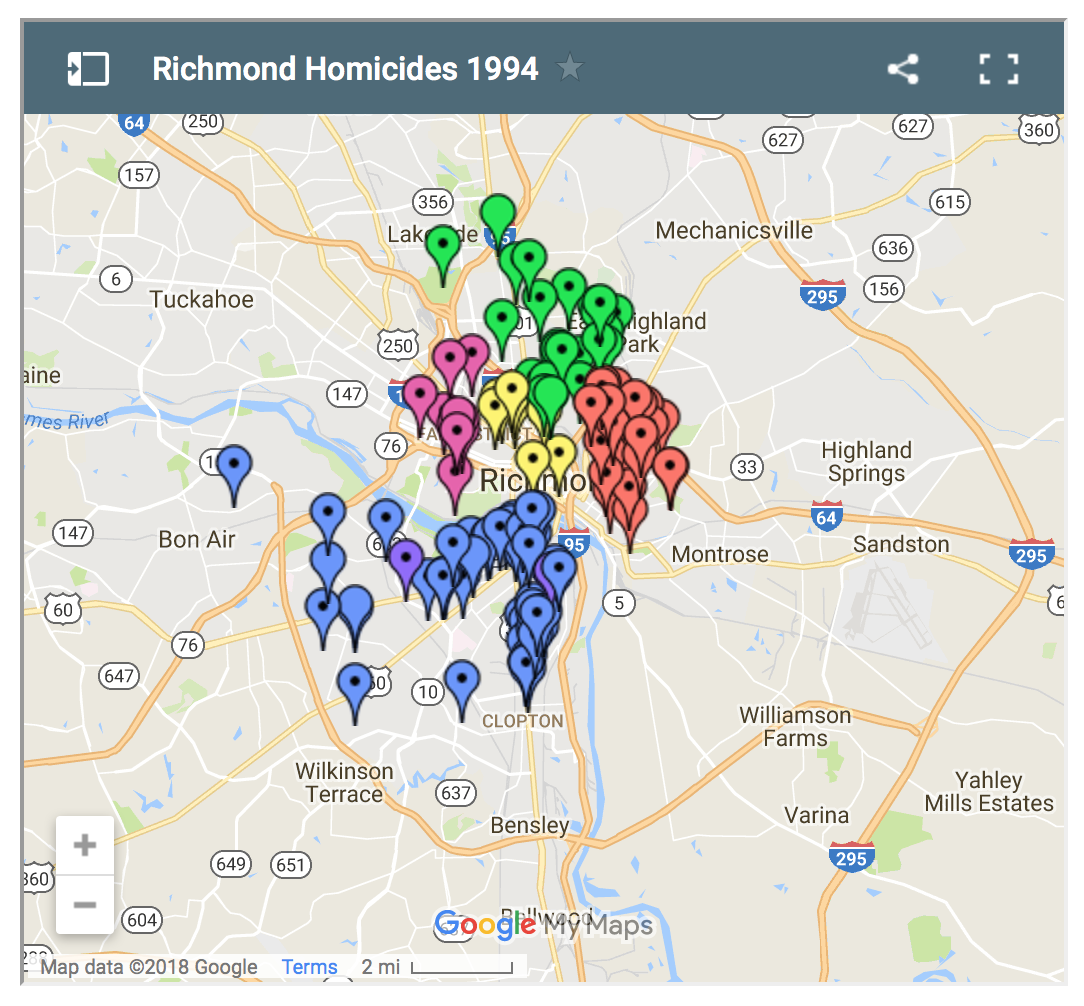
VIEW:

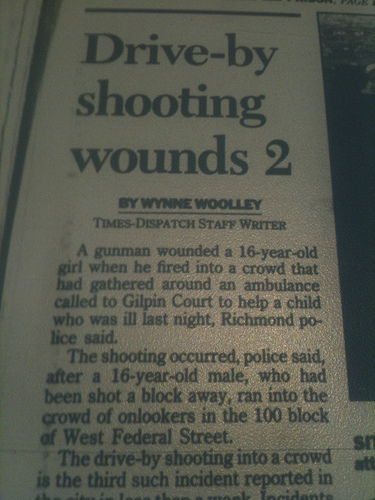
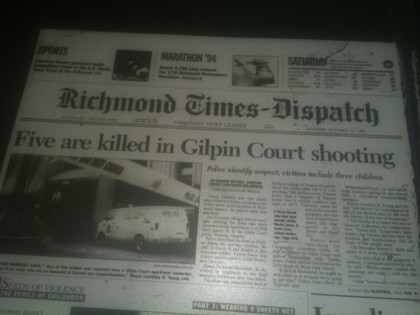
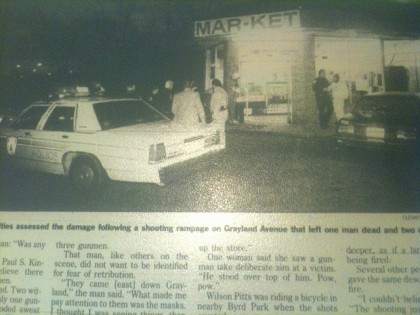
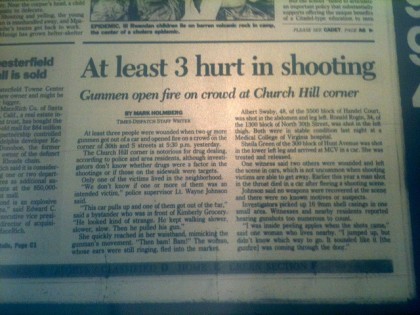
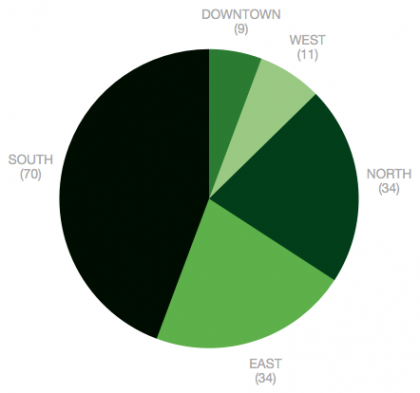
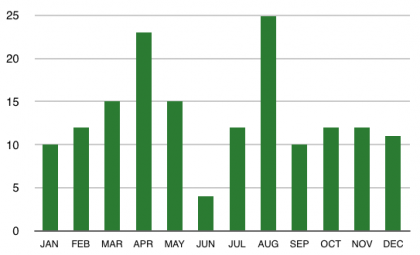
Wow. Excellent reporting! I did not live in Richmond in the 90’s. When I stated I was moving here, and to Church Hill, Richmonders tried to warn me away from this area. People who are from Richmond and its suburbs can’t shake off these 10-20 year old images, reported above. “Newcomers”, such as myself, are under no preconceived notions. We are able to see an area with more realistic eyes.
Thanks to all the original “pioneers” for sticking through the horrific, scary times, and making this an awesome area in which to reside!
Extremely well done John. Thanks.
Awesome. I live at the corner of Mulberry/Parkwood and would have to agree that there has been insane improvements. Some of my neighbors have lived here for 35-45 years and tell about the crazy stuff that went down. I see a lot of drug activity still, but nothing too far off from normal city living.
Thanks for the superlative for Maymont/ByrdPark/Randolph. A lot of people around the neighborhood describe the streets as about as safe as the Wild West back in the days when drugs were the top priority for many in the community. They say it’s like night and day between then and now. I’ll be excerpting this story for a ByrdPark.net feature so people can reminisce and/or thank their lucky stars.
Great article though I wonder what exactly would make the author remark that they would not be surprised to see a body “drop” on Venable? Venable is a major Street in Union Hill that is in need of physical help but it is not a particulary dangerous Street . The lower Mosby housing development has great impact on this section of Church Hill even though that particular development is comparatively safe considering the other eastend housing developments in recent years. I would be very surprised to have a murder happen on Venable and completely disagree with your statement about Venable and wonder why you would say that and what facts you are using to make such a derogatory statement?
Over the shorter term or in smaller areas, homicide numbers in the city tend to vary considerably from period to period. I found that assault numbers seem to be more representative in those instances: http://img237.imageshack.us/img237/4969/clipboard01le.jpg
Really good job John. Excellent work. I lived through the carnage of the early 90’s in Richmond, although not on the hill. You are soooo right about not being able to shake the images of those times from my head. So much of the violence seemed to be related to crack. IMO, things could EASILY get that bad again. No jobs, dispair, a broke government, easy drugs and a lack of hope and change could put us right back as the murder city. Lets hope it doesnt. Again, good work chpn!
If I was grading this as an undergraduate research paper, I’d give you an A. Really great job assembling all the data and making sense of it!
This article is an exhample of why CHPN was awarded the best community blog award this year. Well-done!!
Wow, amazing work! I have to admit, the story about the 14 year old and her family broke my heart. I wonder what happened to her and her little sister Kenya?
I have to say I agree with Kaykay. When I told my uncle I was moving to Richmond 7 years ago, he was really concerned for my safety because of what he’d heard. I love being a Richmonder. I’ve lived in Church Hill and on the west end (which doesn’t count). Now, I own a house in Montrose. This city has so much potential. And this story is proof.
@C. Wayne Taylor – That’s interesting. Could you run that back a little further?
@julestools – I specifically had in mind Venable and Pink Street, to 24th and Cedar. Nothing seems to abate the obvious drug dealing going on at that stretch. Is my perception that far off?
@CM – thanks & that’s funny! While I was putting this together, I kept wishing that I could hand it over to a real writer to see what would come out.
I was around in the 90’s and remember many of these murders. Four points to consider:
1. The majority of crimes and shooting was black on black (and, sadly, that is likely still the case). I know that its not cool to always inject race into these discussions, but it is an important aspect of why a lot of white Richmonders might not recall 1994 as ‘Richmond’s worst year’. I know as a young white guy back then why I felt much safer in the Fan than East End.
2. While these murder are very tragic, it is street crime. It would be interesting to compare the street crime to the white collar crime going on at the time- Joel Harris-style corruption for example. In my opinion, Richmond has a history of overlooking white collar crime and its possible relationship to the street crime. Yes, Chuck Richardson went down for heroin, but how does compare to Mayor Young’s arrest? The reason why we have questions of mayoral power now are directly related to that. Before French there were other developers who were investigated by the FBI.
3. The modernization and reform of the Richmond police department has been a great benefit to residents. Forensics, community policing, and overall professionalism have made huge differences. I am very appreciate of the police department’s hard work, of course.
4. The overall national demographics play a huge part in the story. Many, many criminals have simply aged to the point that they are no longer the great threat that they were.
Assaults – City-wide
2000 through 2010:
http://cwaynetaylor.wordpress.com/2010/08/16/crime-assaults/
From the link above:
A 20% drop in assaults/year 2000/2010, a 55% drop in homicides/year/per capita 2000/2010.
Less of a direct connection that I would’ve expected, but still nice to see the trend.
I’d be interested in seeing Aggravated Assault numbers for the past 10 years (or more) if anyone reading has access…
Most of the violence of the 90’s was tied to the drug trade. And, unfortunately, I remember several friends and acquaintances that got involved as users. Heroin use was popular, even among “good” college kids. Quite a few died.
But business was good, and that’s why the drug trade and its attendent violence flourished here in Richmond.
I moved here to Church Hill in 1992. At that time, the Fulton Hill Hustlers were active in the area as crack and heroin dealers. Many of the kids in this gang were 15 or 16 years old. There were reports of “drive-by” shootings done via bicycle as the shooter did not have a driver’s license yet. It was indeed a scary time, but if you did not buy or sell drugs, you could stay out of their sights.
No, the Fulton Hill Hustlers were not Crips or Bloods, but I think they left at least 10 bodies in their wake.
I just re-read my post, and I think the point I wanted to make is in regard to the comments about “black on black” crime. The drug dealers cannot operate if there is no market for their wares. And in the 90’s, at least, many, many of the consumers were white.
Google News Archives: Fulton Hill Hustlers
Man that was a depressing year…
THings that also happened in 1994:
* Clinton’s health care attempt
* George Allan takes office
* Disney tried to open a theme park in VA
* North vs Robb vs Coleman for Senate
* invasion of Haiti
* OJ Simpson chase
* baseball strike
* Paper Moon tried to open on 18th Street
* fire at St.James on Franklin Street
* Sharon Bottoms custody case was going through the courts
* Susan Smith drowning her boys, blaming it on a black car-jacker
* Republican Revolution in November gave control of Congress
* Unabomber killed a man in New Jersey
* Kurt Cobain died
Thanks as usual for great reporting. Interesting walk back in time.
Super article. I, for one, am glad those days are gone.
John, you’re too modest. A real reporter would have editors and plenty of guidance and help. You had an idea for a story and nailed exactly what media should be taking the time to do more often. You have great ammunition for the school year now…great summer project!
Crack and the early 90’s, ‘dems were tha’ days.
Great job! I didn’t move to R’mond until 1996. This explains ALOT about why my west end friends were so afraid for me moving to the Fan in 1997 and then when I told them I’d bought a house in Church Hill in 1998.
simply the best news article/reporting to come out of Richmond in a long time.
I think so and I hope we do not have a murder on that street.
Legalized drugs mean that people don’t have to resort to violence to settle disputes. Walgreen’s and CVS aren’t shooting it out with each other over territorial disputes.
John — amazing job. It brought back a lot of cringes, but relief that those days are hopefully gone for good. I moved here in 1989, incidentally.
I befriended the chef at the Chinese Restaurant on Grace a few months before his untimely, and baffling, death. He showed me his technique for making ‘proper’ stirred fried rice — something I remember to this day.
Who was Carrie Davis, who was killed on Harrison Street? Was she a VCU student? Any details about what happened?
Carrie Davis, a 78-year-old woman who lived in the big retirement community on the 1000 block of Grace Street, was one of 2 older women killed inside their apartments that year. Virginia Ross was also found murdered that year in another retirement high-rise in Northside on the 1600 block of Fourth Avenue. A man was arrested for the killing of Ms.Ross, and he was later connected to the death of Ms.Davis.
Thomas McTernan, beat to death on the 300 block of North Harrison after a party at the Kappa Delta Rho house, was a lance corporal in the Marines and the son of a Richmond police detective.
I know some weird shit now from putting this together.
John – do you know if this is true? Unfortunately, the FBI no longer publishes its rates in a manner by which you can easily see city comparisons.
http://transitionalneighborhoodlowdown.wordpress.com/2011/02/17/is-richmond-1-in-homicides/
I bet that’s a typo, Richmond CA has taken our old spot at the top of those lists.
We had just a hair over 20 killings per 100,000 residents in 2010, a number on par with recent years and a far cry form a high of 81 per 100,000 in 1994.
Here is a graphic of the worst 10 in 2009…
Good work John thanks
My great-grandmother is from Blackwell. She lived there before they tore it down and built the projects. She then move back there. That’s when I remember her. Those hot cinder blocks walls on the inside of her house.
I’m 48 years old.
To make a long story short I was born and raise on Southside. Oak Grove elementary is the school I started at. After my parents divorce we moved uptown.
I was raise uptown South Side. I then went to Franklin elementary to Elkhart Middle then to George Wythe High. Graduating two years late. I’m also going to spare you the sad stories of my association with the streets, funerals, after-hours spot and the main culprits “crack cocaine” and Sothern Gun World.
Book
Uptown Southside for life
peace
HOLMBERG: 25 years after the deadliest invasion since the Civil War
http://wtvr.com/2012/05/24/holmberg-25-years-after-the-deadliest-invasion-since-the-civil-war/
Excellent reporting! These are the kind of statistics I enjoy reviewing, although unfortunate.
Wow, I never knew that this report existed. That was a terrible time for Richmond. My brother was the 47th homicide victim that year in April, on Lynnhaven Ave. It’s a totally different place now.
I moved to Richmond in ’89 and trust me, from 1990-1999, violence and crime was like that here in VA! We knew what areas to stay away from (Gilpin Court, Whitcomb Court, Fairfield, etc.) and got used to hearing gun shots and running away. I’ve lost over twenty friends and acquaintances to gun violence during those long years. Over half of them were gunned down while the others were doing the shooting and are spending the rest of their lives behind bars. So many young lives lost over drugs and money. And I especially remember the case of Tamika Jones because we were the same age and I remember how older men were always trying to pick up young girls my age or a little older. Although things have gotten better, there is still a lit of room for improvement.
I really would like to know more info on the murder of Harold David Robertson Jr. He was killed Feb.5 1994 near Jeff Davis Hwy in Richmonds south side. .please..
Correction Robinson is his last name.
You can go to the RTD online archive at http://www.timesdispatch.com/archive/ and search older articles.
The only one that I can find is the story MAN IS KILLED IN SHOOTING ON SOUTH SIDE from February 6, 1994 that starts off:
“A 24-year-old man was shot in the head several times early yesterday in South Richmond and died less than an hour later. Harold D. Robinson Jr., of the 1500 block of Gunn Street, was found about 3:30 a.m. in the first block of Jefferson Davis Highway, where the highway intersects with Decatur Street, police said. He was taken to a Medical College of Virginia hospital where he died, police said.
Police said Robinson was shot with a handgun.
“There were no witnesses, no…”
You have to pay to read the rest of the article.
John, This was a great idea for several reasons. Those of you who think that nothing can be done for the neighborhood until crime is curtailed are mistaken. Crime is managed while at the same time working to improve other things that are just as important. I am a big believer in the broken window theory!
Most of the violence in the 1990’s was attributable to a family called Briley. The ” Briley brothers ” were a gang of drug dealers who permiated the Church Hill area and were responsible for murders, robberies, assualts and stealing in general.
\When they were finally caught and jailed, their mother said, “they was good boys, whenever the electricity went out they always came home with a generator.” They made a well publicised prison break before they were executed.
I was actually warned by the police to be careful because “these guys monitor the police channel and know who is calling the police”! A usual police response to a call back then was , “what do you expect when you live up here”? And , there were “no witnesses” because these guys had a bad habit of killing anybody that spoke up!
I have been shot at while walking along the park where the basketball courts are. This happened more than once. There was a well known drug house directly across the street from me that was one of the distrubution centers for this gang. This was well known by the police who told me “what do you expect when people on City Council are known cocaine users”?
I think things are much better than they used to be.
I haven’t been shot at for at least a month!!!
To add one more macabre item to this horrible year – in April, 1994 Timothy Spencer, aka the Southside Strangler for his murderous rampage on the Southside in 1987, was put to death.
I almost forgot, I had a cook out the night the the Briley bros. (one at least) were executed. Everyone wore shower caps (whenever they were shown on the news, they always had on shower caps) and we turned off all the lights to make sure there was enough electricity for the deed.
If anybody who was at this cook out reads this, call me. Nobody that lived here at the time is still here, except me.
The Briley Brothers’ crime spree was 1979. They were both dead by 1985. http://en.wikipedia.org/wiki/Briley_Brothers
Thanks John, I have lost track of time.
Great research, and great job, John. Thanks for taking the time to do this.
#40 on the list, Debbie Gray, was my aunt and one of my best friends. I am assuming the date is the date of her death? I distinctly remember her being shot on Friday 4/1/1994 but she died in the early morning of 4/2/1994 after my family made the decision to take her off of life support. Thank you for putting this list together. I with we could find the person that killed her and honestly wouldn’t be surprised if they are not on your list after her murder.
Does anyone know the story behind “an infant was basically boiled to death”?
i’m a 37 year old white female and grew up in highland springs. my first apartment was in church hill in 97. it’s every bit as dangerous as this article says it was. so many drugs coming through the area. a lot of violence. i found a body next to my car one time. heard drivebys sitting out front on N 24th/Clay. crack houses everywhere. i know people that killed and were killed. no one came to see me there and i had a rottweiler. but i was determined to live on my own and it was all i could afford. chimbarozo park was crazy dangerous. richmond was dangerous. it’s come a long ways.
great job on doing your homework about richmond , back in the days, it was crazy back then
i was a part of all the madness in Richmond back then. being a young jamaican hustler holding it down in Dodge City. as a member of the infamous Poison Clan Posse i saw first hand some of the violence that took place back then and i can confirm what you guys are saying. Despite all the madness though, i loved RIchmond. both my kids were born in Richmond. a lot of folks were disappointed in me when they found out about my gang affiliations. i apologize for the mayhem myself and my associates caused back then. and pray for the famalies of victims killed by my former associates. most of us from the Clan have all done time or is still locked up. i can only imagine that Richmond is a very different place from what it was back in the 90s
Ron
I am curious to hear what your opinion is on why the homicide rate went from 161 in 1994 to 37 last year. Do you think that Federal Incarceration programs like Project EXILE played a part? And how do we keep that from ever happening again, in your opinion?
We moved to Church Hill in 1999. The house we bought was not on the market and a friend at the time turned us on to it. Unfortunately after they had hyped how great the area was he moved out after being robbed in his house at gunpoint. Little did we know about how bad the area still was then even only 2-blocks off of Broad.
The house next door was owned by the notorious slumlord Stan Smith. We saw a couple of evictions and then the house condemned. The people living there were always in trouble or being watched by cops and feds. The mother had to work two jobs while the father was out of the country working so the kids were on their own most of the time hanging with the wrong crowds. Drugs passing through all the time, saw an attempted murder outside, a brother beating on his sister (different incident), us being harassed even trying to get in and out of our cars – even with them walking right up to us. Even had a bullet shot through our living room window but never found the slug. A neighbor saw guns being run out of a van around the corner by the barber shop recently mentioned at 27th and Marshall. Break-ins all the time so businesses didn’t stay.
A second job I had for a while was selling newspapers at the Times Dispatch (phone sales) and they would not even deliver to most of Church Hill then! Too dangerous.
But once houses were being renovated things turned around. The bad elements were basically forced out through gentrification.
I’ve been trying to look into a homicide committed on august 14,1987..the victim was Jeff Davis, his killer was terry oconner page, I can’t find anything on this particular homicide maybe because it was so long ago but if anyone can point me in a direction.
I moved to Richmond in 1992 to go to Virginia Union University. I was thinking of the “Virginia is for lovers’ commercials and trips to Virginia Beach when I decided to go to school in VA. I certainly did not have any idea of how dangerous the area was wow. I am very thankful that I did not wander into harms way. I left Richmond in 1999.
This a awesome report. Im a 30yr old Richmonder, and I was 10 during this time and i remember most of all these. My uncle’s used to come and tell me the stories about some of the things he saw down Afton and just by hearing the stories had me shook. But wasn’t nothi g like the Gilpin court massacre I remember that like it was yesterday, how ol boy ran in the house and killed everything moving. I must say how Richmond has come along way from back.
I was one of the medics caught up in that mess. My rewards, in 2017, are all related to dancing in and out of the nightmares that dominated Richmond’s realities. I rarely visit ( I am cross-country), because those sights, smells, and sounds do not go away. I am happy to hear that reality is gone.
Richmond was known as “The Murder Capital” back then.
I was born and raised in Richmond in Church Hill. I never did or sold drugs, never got involved in any crimes and didn’t associate with anyone who did.
There was drug violence across the country but because the news picked and chose what crimes to report on, the world only saw black on black crime and those stereotypes have prevailed to this day. Not all blacks raised in poor crime ridden areas are “products” of their environment.
There were tons of good upstanding law abiding citizens living in all of the areas mentioned in the 80s and 90s. Someone said things changed because of gentrification? I’m sorry but white people don’t have crime?
In the 90’s Richmond was majority black and in the areas mentioned the population was more dense. So of course the stats would look like blacks were just killing each other and nothing else happened as far as crime. Movies and the hype of gangsta rap did help each. Portraying our communities as death sentences for anyone looking to move to an area.
Here is something to ponder: compare a 1-mile area where 20 people live and one of those people was a serial killer who murdered 15 people over 15 years to a 1-mile area where 200 people live and 5 of those people killed 1 person each and were put in jail that same year. Columbine happened in 1999. Waco happened in 1993. I tell this to anyone who look at me sideways about why I chose to live in the area I grew up in.
At least I know the police are just around the corner and will be at my door in less than 5 minutes if I call (and I’ve called before). I’ve been in my house 13 years and God-willing I’ll be here for many more. I love my city. Just something to ponder.
This was a great rendition of a small portion of how is was back then, the article did not seem negative to me but honest. I lived in it, through it and because of God’s grace made it. I can ride down some streets and still remember how it was in my mind. I love the change and realize that there is still much room for improvement.